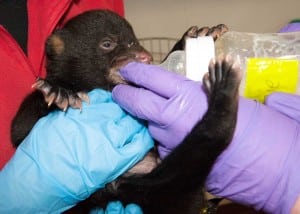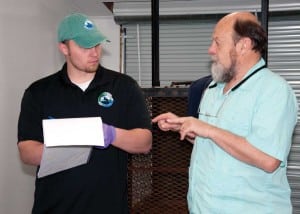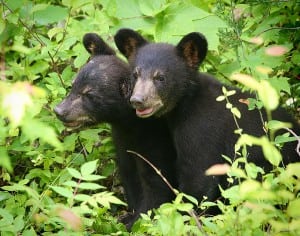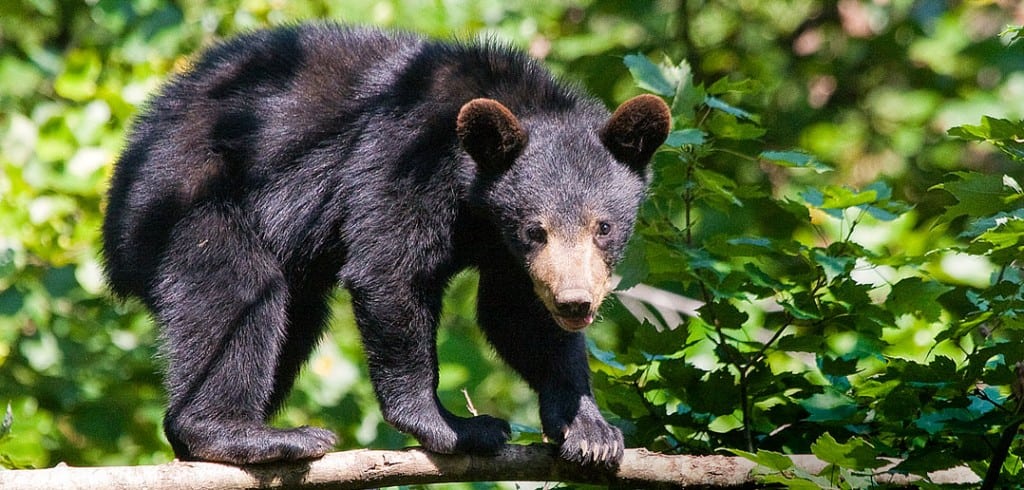Appalachian Bear Rescue begins 20th year of returning black bears to the wild

The two bear cubs were visible from the Blue Ridge Parkway. It was now late summer, and they were much smaller than most cubs by this age. Their mother, always close by, was nowhere in sight. When the mother bear didn’t return after several hours, a visitor called the wildlife authorities.
The cubs didn’t know it, but their fortunes had just improved dramatically. They were on their way to a place designed specifically for this kind of situation — a place found only in Tennessee.
If you are a wild bear in Tennessee, 2015 has been a hard year.
In the spring, the cherry trees produced some fruit but not nearly enough for all the wildlife, particularly the bears. Same with the summer berries. The fall brought a widespread mast failure, meaning that nuts and seeds are scarce, particularly the acorns bears depend on to prepare for winter. There were some walnuts and hickory nuts, but these hard nuts will break the teeth of cubs and yearlings.
If you are a person trying to help wild bears, 2015 has been a busy year.
That is particularly true at Appalachian Bear Rescue (ABR) in Townsend. This is where the two cubs were taken and where more than 200 cubs and yearlings preceded them. ABR is the only place in the Southeast where orphaned and injured cubs and yearlings are rescued, restored to health and then set free to enjoy the wild. Next year marks the organization’s 20th anniversary.
Many of the rescued bears share a similar story with the aforementioned cubs — Bear 202 and Bear 203 as the ABR curators call them or Ridgeway and Bonnie Blue as they are known on the organization’s Facebook site.
Name verses number is an important distinction, says Dana Dodd, president of the board for ABR.
“Our mission is to return bears to the wild,” she says. “We care for them and get them back to health. We also educate so people can live safely around bears and do research where it’s possible to help black bears.”
But what Dodd returns to again and again in the emphatic, no-nonsense tone of a serious advocate is that everything they do at ABR is designed to allow wild black bears to remain wild. In the wild, bears do not have names; likewise at ABR, the bears are never called by name.

Wild-ready
ABR’s three curators play a major role in getting bears “wild-ready.”
Coy Blair, Janet Dalton and Rick Noseworthy are the only people at ABR who have contact with the bears. Virtually no one else is even allowed to go in the facility where the bears are. Even the curators have minimal contact with the bears — and no contact after the cubs reach around 15 pounds.
The minimal contact philosophy starts the minute the cubs arrive.
“Most of the time we get a call from a state or federal wildlife official,” says Blair, the organization’s newest curator. “We find out everything a person knows about the cub, which often isn’t a lot, and then develop an individual treatment plan.”
Occasionally, ABR will know where a sow is in the wild and see if she will take a cub in and feed it. But far more often, says Blair, the plan means bottle-feeding the cubs until they are able to lap milk replacement from a bowl.
And although they are teddy-bear look-alikes and small enough to hold, the curators do not cuddle or comfort the cubs and yearlings.
“When we feed them, we wear gloves,” Blair says. “We never use cologne or perfume and try to keep from transferring any of our scent to them. As we feed them, we face them away from us. We don’t talk to them. It is total silence when we care for them.”
Between feedings, which are required every two to three hours at first, the bears stay in the cub nursery — cages where they can walk around but still be under the curators’ watchful eyes.
When they are up to 15 pounds or so and able to eat soft foods, the cubs progress to an outdoor pen where they are protected from the elements but still get a sense of the outdoors. Their diet changes, too, now including fruit and applesauce in addition to the formula.

“We promote natural foods here,” Blair says. “Berries, grapes, acorns, nuts, apples and pears. In a short time, this really helps put the weight on them and get them up and running.”
As they gain strength, the bears begin to huff at the curators, warning them to stay away. The bears don’t like their caretakers because they are instinctually wary of humans. That’s normal bear behavior and, thus, just what the curators hope to see.
The final step before release is a wild enclosure.
“There are four half-acre wooded areas with real trees, grass and rocks surrounded by a thick blind,” Blair says. “The blind is 8 to 11 feet tall.”
All human contact ends at this point.
Gloved curators throw washed food over the blind, and the bears forage for it the way they would in the wild. Bears interact with other bears. Then, when deemed healthy enough, each bear is tranquilized, transported back to where it was found — and released.
Wild once again
At their release, the bears typically weigh more than they would in the wild, according to Blair. Whereas a bear in the wild might weigh 50 to 75 pounds, a similarly aged bear released from ABR would weigh 100 to 125 pounds. He said this gives them a buffer as they acclimate to foraging on their own.
“Their release is a quick and quiet thing,” Blair says. “They bound from the cage and run into the forest.”
The entire process is deeply gratifying, the curator says.
“When the cubs come in, we see them at their worst,” he says, “but when we give them a second chance, they run with it. It is very rewarding to know that this animal would have been dead without this organization.”
“We see bears here every day, but that is nothing compared to seeing them in the wild,” Blair adds.
Bears 202 and 203 — Ridgeway and Bonnie Blue — were healthy, hefty and appropriately wary of humans when released. Someday you might even see them as you drive down the Blue Ridge Parkway.
Appalachian Bear Rescue has helped 19 bears this year already and expects still more due to the mast failure. That compares to just four bears last year when food was plentiful. Learn more about the rescue and find out how you can help and volunteer at the organization’s website, appalachianbearrescue.org. There’s also a Facebook page where you can read about individual bears and watch videos.

New Visitors Center
Appalachian Bear Rescue’s new Visitor and Education Center opened year-round in 2015. Unlike the bear facility, the Visitor and Education Center is open to the public. There you can watch videos featuring cubs the organization has helped since 1999 as well as talk with volunteers. ABR also teaches classes for children and sessions on how people can coexist with bears.
Located at Trillium Cove Shopping Center off East Lamar Alexander Parkway on Highway 321 in Townsend.
Open Mondays, Wednesdays, Fridays and Saturdays from 10 a.m. to 2 p.m.
Call 865-448-0143. No appointment is needed.
Website appalachianbearrescue.org
Keeping Tabs
Beginning this year, all bears released from Appalachian Bear Rescue will leave with a GPS tracking collar.
“We need the data to improve our protocols,” says ABR Board President Dana Dodd. “We need to know what the cubs do when they are released. Are they capable of being wild bears? Do they stay away from trash and people? Do the females remain viable and reproduce?”
The answers to those questions and many more go directly into practice at ABR, she says.
“As the organization grows, we become more and more scientific,” says ABR curator Coy Blair.


